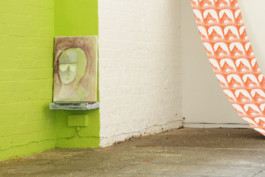
Kate Hawkins
Escape the Esplanade
LIMBO, 2013
27 July - 18 August 2013, Fri-Sun 12-5pm
Preview 26 July 2013, 6-9pm
I was artistic co-director at Limbo between 2010 and 2015, and led the programme between 2012 -15 working with a team of wonderful Kent-based artists, curators and writers, including Daniel Bass, Helena de Pulford, Mike Foreman, Tam Hare, Jo Murray, Lizzy Rose, Sam Slattery and Charley Vines. The programme was generally not prescriptive - we invited artists whose work we really admired to work with us and did our best to support their ideas as well as we could.
Escape the Esplanade addressed the dichotomy between the spectacle and the spectator by positioning a set of works in a manner that alluded to the composition of the nearby High Street, forming a central path through which the viewer was asked to navigate, ‘overlooked’ by ‘bystanding’ paintings and structures.
Much of Kate Hawkins’ work draws from the discourse that surrounds performance and theatre. Her previous performance-based practice notably informed this show. For Escape The Esplanade Kate made paintings as a means to de-activate the performer/viewer paradigm, thereby encouraging the spectator to adopt the role of performer.
The viewer was persuaded to partake in active engagement with the work, and, in doing so, enact a parallel performance of sorts.
Escape the Esplanade was both an invitation for participation from the viewer and a response to the structure of the Limbo project space. The length and shape of the space lent itself to a practical act of walking-through, an act that is similarly directed by the structure of a street, catwalk or pier. The paintings reference street-style blog images, but here the label ‘street style’ took on dual meaning where both the spectator and artwork could be viewed as potential ‘performing’ subjects. This shift in viewing positions served to highlight the act of looking which was further played out through the use of motifs such as lenses and lengthy eyelashes.
Situated behind Margate’s High Street, Limbo is comparatively ‘backstage’. In engineering this conflation of spectacle and spectator, Hawkins offered a reflection of the ‘front stage’ while retaining an honesty about backstage mechanics and processes of display.
www.katehawkins.co.uk










Kate Hawkins
Escape the Esplanade
LIMBO, 2013
27 July - 18 August 2013, Fri-Sun 12-5pm
Preview 26 July 2013, 6-9pm
I was artistic co-director at Limbo between 2010 and 2015, and led the programme between 2012 -15 working with a team of wonderful Kent-based artists, curators and writers, including Daniel Bass, Helena de Pulford, Mike Foreman, Tam Hare, Jo Murray, Lizzy Rose, Sam Slattery and Charley Vines. The programme was generally not prescriptive - we invited artists whose work we really admired to work with us and did our best to support their ideas as well as we could.
Escape the Esplanade addressed the dichotomy between the spectacle and the spectator by positioning a set of works in a manner that alluded to the composition of the nearby High Street, forming a central path through which the viewer was asked to navigate, ‘overlooked’ by ‘bystanding’ paintings and structures.
Much of Kate Hawkins’ work draws from the discourse that surrounds performance and theatre. Her previous performance-based practice notably informed this show. For Escape The Esplanade Kate made paintings as a means to de-activate the performer/viewer paradigm, thereby encouraging the spectator to adopt the role of performer.
The viewer was persuaded to partake in active engagement with the work, and, in doing so, enact a parallel performance of sorts.
Escape the Esplanade was both an invitation for participation from the viewer and a response to the structure of the Limbo project space. The length and shape of the space lent itself to a practical act of walking-through, an act that is similarly directed by the structure of a street, catwalk or pier. The paintings reference street-style blog images, but here the label ‘street style’ took on dual meaning where both the spectator and artwork could be viewed as potential ‘performing’ subjects. This shift in viewing positions served to highlight the act of looking which was further played out through the use of motifs such as lenses and lengthy eyelashes.
Situated behind Margate’s High Street, Limbo is comparatively ‘backstage’. In engineering this conflation of spectacle and spectator, Hawkins offered a reflection of the ‘front stage’ while retaining an honesty about backstage mechanics and processes of display.
www.katehawkins.co.uk








